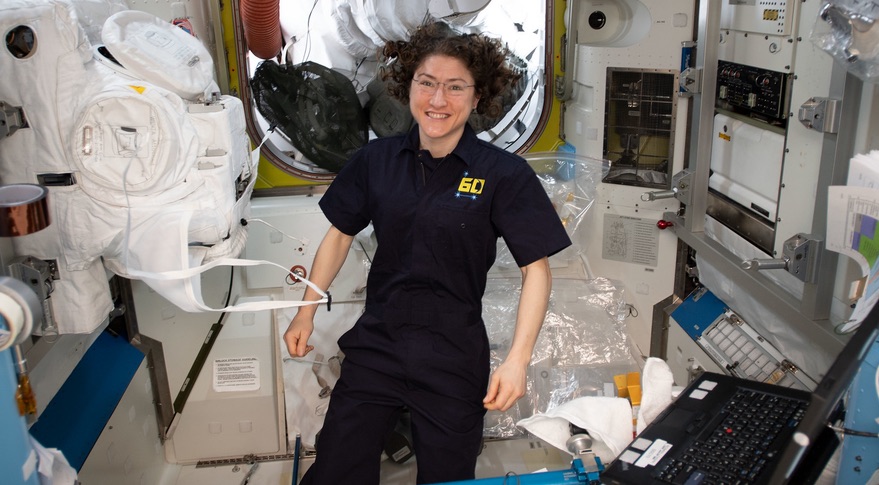
For me, there was no better place to celebrate Women’s Equality Day than right where I am, orbiting 250 miles above the planet’s surface aboard the International Space Station.
On Aug. 26, we recognized the adoption of the 19th Amendment to the U.S. Constitution, the first step to empower women with the right to vote. Women’s Equality Day reminds us of the visionary women who were undeterred in seeking their dreams and led the way for others to pursue ambitions and create future opportunities on Earth and beyond. This year, I stand on the shoulders of these heroes as I reflect on what this day means from this vantage.
First off, I am struck by having the privilege of working and living aboard the space station and contributing to a program that not only brings benefits to all through exploration on the frontiers, but does so as part of a diverse and international team that has shown through its success the power of inclusion and equality.
Onboard the station, we conduct research in microgravity that expands human capabilities. Whether developing technology for 3D printing human organs, studying diseases like Parkinson’s and Multiple Sclerosis or learning how to improve materials and industrial processes, our research capitalizes on the lack of gravity off the Earth while bringing benefits back to Earth.
Our research also benefits future space missions as we test new technologies to purify and recycle air — a critical element to enable missions to the moon and Mars. Other systems we test include advanced spacesuits for crew members to take that next giant leap on the moon — spacesuits that will fit astronauts of all shapes and sizes who have a dream to explore.
Today, @Astro_Christina logs 164 days in space — halfway to her record-breaking 328 day mission, & on the same date as #WomensEqualityDay. Koch is conducting hundreds of experiments that pave the way for #Artemis missions to the Moon & Mars, as well as improve life on Earth. pic.twitter.com/oOyHLBk9EF
— Intl. Space Station (@Space_Station) August 26, 2019
This groundbreaking work is supported by a global partnership of 15 nations and five international space agencies, plus a commercial space industry that is thriving. During my mission, I will have lived in space with colleagues from the United States, Russia, Canada, Italy and the United Arab Emirates. I will have worked not only with ground teams at NASA but also with space centers in Europe, Russia and Japan. I will even see the arrival of commercially designed and built crewed vehicles to the space station.
Women’s Equality Day was extra special for me as an American woman in space. I’m honored to be working at NASA at a time when women will apply the same dedication that drove the suffrage movement to accomplish yet another historic milestone — going to the moon.
NASA recently launched the Artemis program, an effort to send the first woman and next man to the lunar surface. Named after Apollo’s twin sister, this program will return humans to the moon by 2024 and establish a sustainable presence there by 2028. The mission will continue the scientific exploration that the historic Apollo mission began more than 50 years ago, and empower humans to travel to Mars and beyond. This time, we go in an era when the contributions to the mission are as diverse as the people who dare to dream them.
My astronaut class was equally male and female, and women are strongly represented in NASA’s talented astronaut corps and mission control centers. During my time aboard the space station, two of my fellow NASA astronauts are also women, Anne McClain and Jessica Meir. Within the last year, we will have had three different pairs of female astronauts together in space. That is the same number of female pairs as in the previous 18 years of human presence on the space station.
Today marks the halfway point of my extended mission on @Space_Station and also happens to be #WomensEqualityDay. Today I reflect on how the women who fought for the right to vote inspire me to work hard every day to make the world a better place, in ways both big and small. pic.twitter.com/Upd1wCUV7m
— Christina H Koch (@Astro_Christina) August 26, 2019
My second reflection on what Women’s Equality Day means to me is more personal. Yesterday I passed the halfway point in my mission, and I am on my way to the longest time a woman has spent in space. My nearly eleven-month stay here will help scientists better understand how to support human life for missions into deep space, and my time aboard station will advance critical research on how this environment affects the female body.
NASA’s vision is to go deeper into space, and NASA and its astronauts are preparing to sustain missions of greater duration and distance. A one-way trip to the moon is about 385,000 kilometers and takes about three days, an integral step in testing new technology and systems for more demanding space travel. Someday, astronauts will travel millions of kilometers to Mars and back – a mission that could take two to three years.
The Apollo generation has laid the foundation. But today, we’re part of a new generation – the Artemis generation – ready to lead exploration to the unknown. I hope all young people who dream of exploring the frontiers can picture themselves in space. To achieve bold goals, we’re going to need every intrepid explorer willing to accept the challenge.
As we reflect on the suffrage movement, let’s celebrate the things we have achieved together on Earth and also all the things we can achieve moving forward — from the moon to Mars and beyond.
Christina Koch is a NASA astronaut living aboard the International Space Station.
https://spacenews.com/how-womens-equality-day-looks-from-space/Bagikan Berita Ini















0 Response to "Op-ed | How Women's Equality Day looks from space - SpaceNews"
Post a Comment